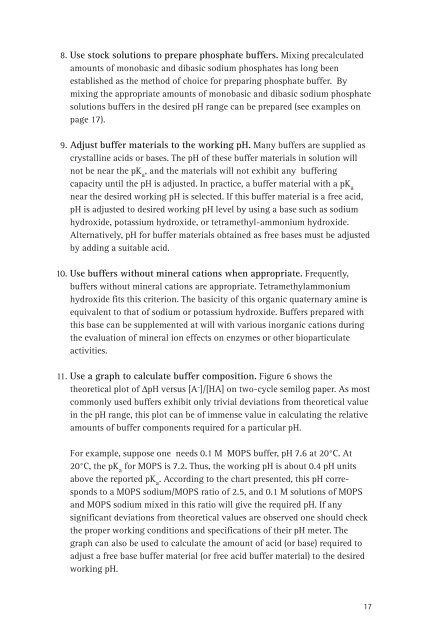A guide for the preparation and use of buffers in biological systems
A guide for the preparation and use of buffers in biological systems
A guide for the preparation and use of buffers in biological systems
You also want an ePaper? Increase the reach of your titles
YUMPU automatically turns print PDFs into web optimized ePapers that Google loves.
8. Use stock solutions to prepare phosphate <strong>buffers</strong>. Mix<strong>in</strong>g precalculated<br />
amounts <strong>of</strong> monobasic <strong>and</strong> dibasic sodium phosphates has long been<br />
established as <strong>the</strong> method <strong>of</strong> choice <strong>for</strong> prepar<strong>in</strong>g phosphate buffer. By<br />
mix<strong>in</strong>g <strong>the</strong> appropriate amounts <strong>of</strong> monobasic <strong>and</strong> dibasic sodium phosphate<br />
solutions <strong>buffers</strong> <strong>in</strong> <strong>the</strong> desired pH range can be prepared (see examples on<br />
page 17).<br />
9. Adjust buffer materials to <strong>the</strong> work<strong>in</strong>g pH. Many <strong>buffers</strong> are supplied as<br />
crystall<strong>in</strong>e acids or bases. The pH <strong>of</strong> <strong>the</strong>se buffer materials <strong>in</strong> solution will<br />
not be near <strong>the</strong> pK a<br />
, <strong>and</strong> <strong>the</strong> materials will not exhibit any buffer<strong>in</strong>g<br />
capacity until <strong>the</strong> pH is adjusted. In practice, a buffer material with a pK a<br />
near <strong>the</strong> desired work<strong>in</strong>g pH is selected. If this buffer material is a free acid,<br />
pH is adjusted to desired work<strong>in</strong>g pH level by us<strong>in</strong>g a base such as sodium<br />
hydroxide, potassium hydroxide, or tetramethyl-ammonium hydroxide.<br />
Alternatively, pH <strong>for</strong> buffer materials obta<strong>in</strong>ed as free bases must be adjusted<br />
by add<strong>in</strong>g a suitable acid.<br />
10. Use <strong>buffers</strong> without m<strong>in</strong>eral cations when appropriate. Frequently,<br />
<strong>buffers</strong> without m<strong>in</strong>eral cations are appropriate. Tetramethylammonium<br />
hydroxide fits this criterion. The basicity <strong>of</strong> this organic quaternary am<strong>in</strong>e is<br />
equivalent to that <strong>of</strong> sodium or potassium hydroxide. Buffers prepared with<br />
this base can be supplemented at will with various <strong>in</strong>organic cations dur<strong>in</strong>g<br />
<strong>the</strong> evaluation <strong>of</strong> m<strong>in</strong>eral ion effects on enzymes or o<strong>the</strong>r bioparticulate<br />
activities.<br />
11. Use a graph to calculate buffer composition. Figure 6 shows <strong>the</strong><br />
<strong>the</strong>oretical plot <strong>of</strong> ∆pH versus [A - ]/[HA] on two-cycle semilog paper. As most<br />
commonly <strong>use</strong>d <strong>buffers</strong> exhibit only trivial deviations from <strong>the</strong>oretical value<br />
<strong>in</strong> <strong>the</strong> pH range, this plot can be <strong>of</strong> immense value <strong>in</strong> calculat<strong>in</strong>g <strong>the</strong> relative<br />
amounts <strong>of</strong> buffer components required <strong>for</strong> a particular pH.<br />
For example, suppose one needs 0.1 M MOPS buffer, pH 7.6 at 20°C. At<br />
20°C, <strong>the</strong> pK a<br />
<strong>for</strong> MOPS is 7.2. Thus, <strong>the</strong> work<strong>in</strong>g pH is about 0.4 pH units<br />
above <strong>the</strong> reported pK a<br />
. Accord<strong>in</strong>g to <strong>the</strong> chart presented, this pH corresponds<br />
to a MOPS sodium/MOPS ratio <strong>of</strong> 2.5, <strong>and</strong> 0.1 M solutions <strong>of</strong> MOPS<br />
<strong>and</strong> MOPS sodium mixed <strong>in</strong> this ratio will give <strong>the</strong> required pH. If any<br />
significant deviations from <strong>the</strong>oretical values are observed one should check<br />
<strong>the</strong> proper work<strong>in</strong>g conditions <strong>and</strong> specifications <strong>of</strong> <strong>the</strong>ir pH meter. The<br />
graph can also be <strong>use</strong>d to calculate <strong>the</strong> amount <strong>of</strong> acid (or base) required to<br />
adjust a free base buffer material (or free acid buffer material) to <strong>the</strong> desired<br />
work<strong>in</strong>g pH.<br />
17
















